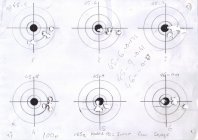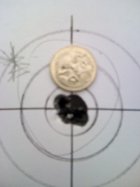Hiyas,
I have been working up some loads using Nosler custom comp projectiles. Today I went out and shot 6 groups and although it was a little windy I didn't think it would affect the sideways drift this much at 100 yards. The wind was gusting at about 10 to 15 mph from the left at about 10 o'clock. Could the sideways drift be a function of the load or is it just the wind and my lack of ability to hold the rifle still. Although I have measured the groups for the elevation deviation I would like to hear anyone's opinion on which group they think is the best just to either confirm or make me rethink my thoughts.
Thanks
I have been working up some loads using Nosler custom comp projectiles. Today I went out and shot 6 groups and although it was a little windy I didn't think it would affect the sideways drift this much at 100 yards. The wind was gusting at about 10 to 15 mph from the left at about 10 o'clock. Could the sideways drift be a function of the load or is it just the wind and my lack of ability to hold the rifle still. Although I have measured the groups for the elevation deviation I would like to hear anyone's opinion on which group they think is the best just to either confirm or make me rethink my thoughts.
Thanks












